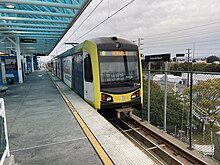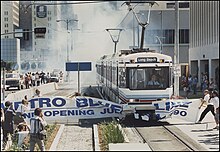Los Angeles Metro Rail
| Los Angeles Metro Rail | |||
|---|---|---|---|
 | |||
| Info | |||
| Owner | Los Angeles County Metropolitan Transportation Authority | ||
| Transit type | |||
| Number of lines | 6 | ||
| Number of stations | 101 | ||
| Chief executive | Stephanie Wiggins | ||
| Website | metro | ||
| Operation | |||
| Began operation | July 14, 1990 | ||
| Technical | |||
| System length | 109 mi (172 km) | ||
| |||
The Los Angeles Metro Rail is an urban transit system in Los Angeles County, California operated by LACMTA or the Los Angeles County Metropolitan Transportation Authority. The system has a total of six lines, with four being light rail (A, C, E, K) and two being rapid transit (B and D). The Los Angeles Metro Rail has 101 stations and connects to the Metro Busway (G & J), Metrolink, Amtrak, and other transit services.
The A Line, the oldest line in the system, runs between Azusa and Long Beach. More system expansions are currently under construction such as the D Line Extension to West Los Angeles.[1]
As of 2023, Metro's light rail system is the second busiest in the United States and its rapid transit system is the ninth busiest.[2]
Current system[change | change source]
Lines[change | change source]
The Los Angeles Metro Rail has a total number of 101 stations serving six lines. The lines used to be named by colors, but are now identified by letters since 2020. Metro also uses the same line letter naming system for its Metro Busway services.[3] Below is the list of the rail lines and how many stations each go to:
| Line Name | Stations | Termini | Type | Opened |
|---|---|---|---|---|
| 44 | APU/Citrus College
Downtown Long Beach |
Light rail | July 14, 1990 | |
| 14 | North Hollywood
Union Station |
Rapid transit | January 30, 1993 | |
| 14 | Redondo Beach
Norwalk |
Light rail | August 12, 1995 | |
| 8 | Wilshire/Western
Union Station |
Rapid transit | January 30, 1993 | |
| 29 | Downtown Santa Monica
Atlantic |
Light rail | April 28, 2012 | |
| 7 | Expo/Crenshaw
Westchester/Veterans |
Light rail | October 7, 2022 |
Stations[change | change source]

Los Angeles Metro Rail has 101 stations. The light rail stations are mostly above ground, but some are underground. Rapid transit stations (B and D Lines) are all underground. Each station has ticket vending machines, maps, electronic displays, and artwork reflecting the local culture. The underground stations generally are larger and have two levels. The top level is where you can buy tickets (see Fares section for more information) and the bottom level is where passengers can board trains. All stations have elevators and ramps so people with wheelchairs can enter.
Fares[change | change source]
To travel on Metro, passengers need a special card called Transit Access Pass (TAP), which they can get from machines at every Metro Rail and Busway station. There are fare inspectors who check if passengers have the card. If you have a TAP card, you can switch between Metro routes for free within 2 hours of your first ride.
Starting from July 2023, Metro has made it easier for people to pay for their trips using a TAP card. They have replaced their 1-Day, 7-Day, and 30-Day passes with something called fare capping.[4] This means that passengers will never have to pay more than $5 (for up to 3 rides) in a day or $18 (for up to 11 rides) within seven days. To benefit from fare capping, you need to use the same TAP card every time you ride. Once you reach the 1-day or 7-day fare cap, you can travel for free. Fares for students, seniors, disabled, or low-income people are even cheaper.[5] The graph below shows the different fare types and their prices.
| Fare type | Regular | Senior (62+)
Disabled/Medicare |
Students
(K-12; College) |
Low Income |
|---|---|---|---|---|
| One-way trip | $1.75 | $0.35 (all other times)
$0.75 (rush hours) |
$0.75 | 20 Free Rides then Regular fare |
| 1-Day Cap | $5 | $2.50 | $2.50 | |
| 7-Day Cap | $18 | $5 | $6 |
Safety[change | change source]
The Los Angeles Metro Rail system has officials from the Sheriff's Department watching around half of its trains and stations. The Los Angeles Police Department and Long Beach Police Department are also responsible for stations within their respective cities. Additionally, security keeps an eye on the system through closed-circuit television cameras.[6]
History[change | change source]

Before the Los Angeles Metro Rail, the Pacific Electric Railway and Los Angeles Railway served passengers of Los Angeles County from 1901 to 1961. However, in 1927, the two systems started replacing their rail lines with buses because more people in the county were buying cars and using them for transportation. In 1958, the systems were taken over by a government agency known as the Los Angeles Metropolitan Transit Authority or MTA. By 1963, all rail lines were completely removed and replaced with bus services.[7]

However, in the 1970s, people started calling for the return of rail transit because there was too much traffic on the county's freeways and roads. The Los Angeles County Metropolitan Transportation Authority (Metro) began building the initial lines throughout the county. In 1980, Proposition A was passed to fund the construction of transit lines. The Blue Line (now the A Line), the first light rail transit line in Los Angeles constructed since Proposition A, opened on July 14, 1990. It originally ran from Long Beach to Downtown Los Angeles at 7th Street/Metro Center station. From its start, the line was very popular requiring Metro to add more capacity to the line in the early 2000s.[8]
After that, Los Angeles's first rapid transit lines (B and D) were opened in January 1993. The light rail system continued to expand with the C Line in 1995, the L Line in 2003 (now part of the A and E Lines), the E Line in 2012, and the newest line, the K Line, opened in 2022.
References[change | change source]
- ↑ Wiekel, Dan (November 7, 2014). "L.A.'s not-quite 'subway to the sea' finally breaks ground". Los Angeles Times. Retrieved 10 May 2015.
- ↑ "Metro Ridership". opa.metro.net. Retrieved 2024-01-25.
- ↑ "LA, meet our new lineup". www.metro.net. Retrieved December 23, 2023.
- ↑ "L.A. Metro Fare Capping Starts July 1 - Streetsblog California". cal.streetsblog.org. 2023-06-07. Retrieved 2023-07-01.
- ↑ "Fare Capping". LA Metro. Retrieved 2023-07-01.
- ↑ "LAPD Officers to Patrol Metro Buses, Trains in the City of Los Angeles". lamayor.org. February 23, 2017. Archived from the original on June 2, 2020. Retrieved July 2, 2017.
- ↑ Taplin, Michael (1991). "City of the Automobile: Los Angeles looks to Light Rail London". Light Rail Review 2. Platform 5 Publishing/Light Rail Transit Association. pp. 27–30. ISBN 1-872524-23-0.
- ↑ "MTA Starts 3-Car Train Service on Busy Metro Blue Line". www.metro.net. Archived from the original on 2021-06-03. Retrieved 2020-01-22.

